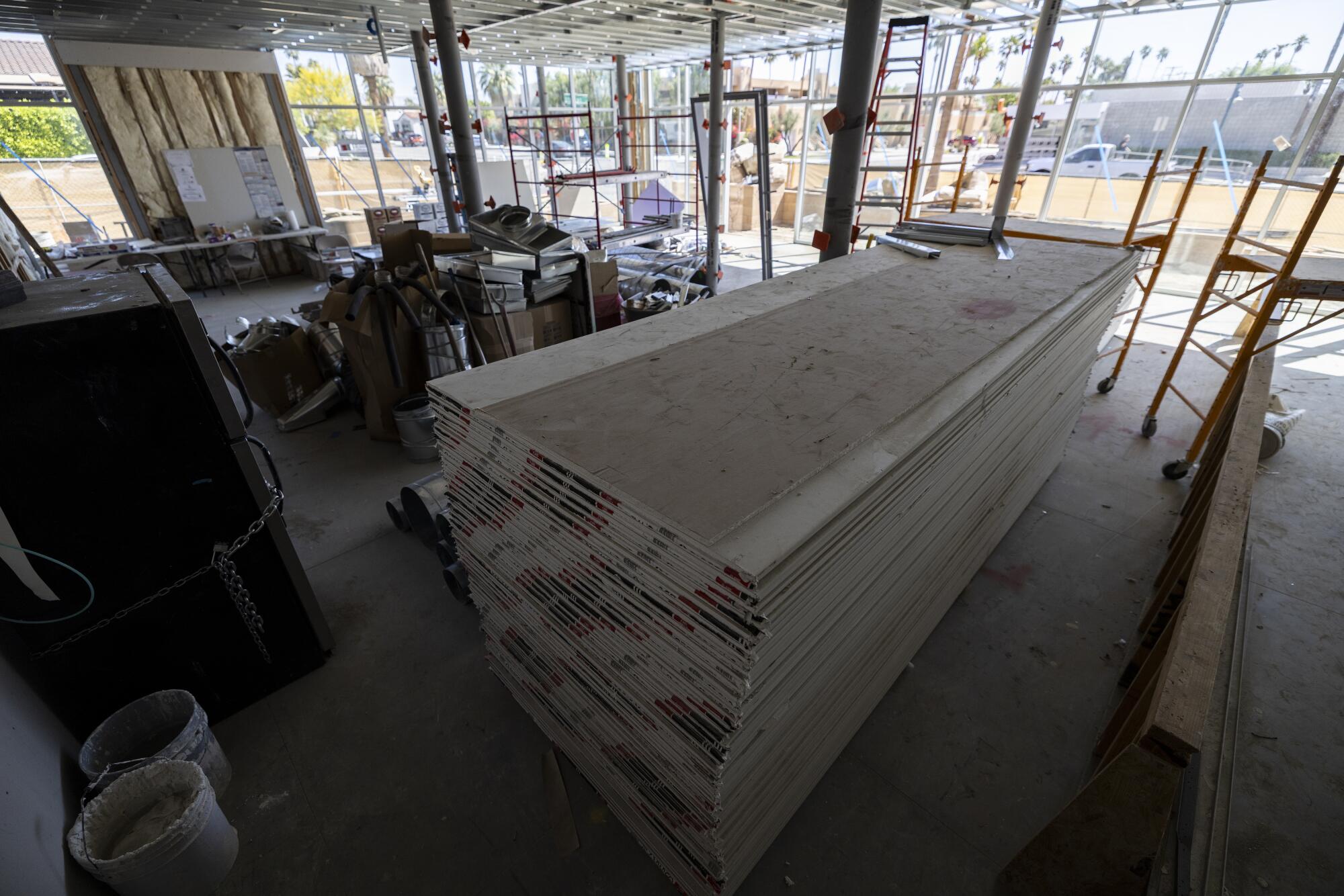Homeless people in detention camps? Fears grow about Trump and Olympics
Local officials and advocates for the homeless are fearful that President Trump will take draconian action against homeless people, including pushing them into detention camps, when Los Angeles hosts the Olympic Games in 2028.
In recent weeks, Trump has appointed himself head of an Olympics task force and has seized control of local policing in Washington, D.C., declaring that homeless people will be given places to stay “FAR from the Capital.”
“Based on everything that has happened so far … I think you would have to be irrational not to worry about a worst case scenario [during the Games], where federal troops are effectively forcing poor people on the street to relocate to what is essentially a detention center somewhere out of sight,” said Gary Blasi, a professor emeritus at UCLA School of Law and a leading homelessness researcher.
On Tuesday, White House Press Secretary Karoline Leavitt said that for now, D.C. police and federal agents will clear homeless encampments in the capital and give people the option of accepting shelter beds and services or facing fines and jail time. The administration, she said, is also exploring how it can move homeless people far from the city.
The White House did not answer questions about whether it has a plan to address homelessness in L.A. in preparation for the Olympics. But White House spokesperson Anna Kelly said, “The people of Los Angeles would benefit tremendously if local officials followed President Trump’s lead to make the city safe and beautiful, especially as they prepare to welcome 15 million people from around the world as the Olympics’ host city.”
When hosting the Olympics, local officials typically try to present the best image of their city, which can include refurbishing landmarks and sports venues or cleaning up areas where homeless people congregate.
“The eyes of the world will be on Los Angeles,” and officials don’t want “people coming to the city and see this visual problem manifest right in front of them,” said Benjamin F. Henwood, director of USC’s Homelessness Policy Research Institute.
French authorities bused homeless people out of Paris before the 2024 Games, and in 1984, the Los Angeles Police Department used mounted horse patrols to scatter homeless people into less visible areas of downtown.
This time, L.A. city and county officials said they will not deviate from their efforts to place homeless people in interim and permanent housing locally.
Last year, in an interview with The Times, Los Angeles Mayor Karen Bass said that unlike during previous Olympics, she would not bus homeless people out of the city and instead would focus on “housing people first.”
Similarly, the L.A. County Board of Supervisors has ordered county staffers to develop an encampment plan for upcoming sporting events, including the 2026 World Cup and the Olympics, that will emphasize permanent housing solutions.
But the supervisors also noted that encampments near Olympic venues will need to be “addressed,” in part to “establish adequate security perimeters.”
In D.C., in addition to taking over the city police department, Trump has deployed the National Guard to, as he put it, “reestablish law and order.” He has threatened to resend the Guard and the military to the Los Angeles area, where they were stationed this summer during federal immigration raids, if needed to maintain safety during the Olympics.
In a statement, Supervisor Janice Hahn said that federalizing local law enforcement and sending the U.S. military to American cities is “what tyrants do.” She also noted that the Trump administration has cut social safety net programs and is seeking to withdraw support for policies that prioritize placing homeless people in permanent housing before addressing other issues such as substance abuse and mental health.
“What the President is doing in DC should concern everyone,” Hahn said. “If he really wants to solve homelessness, he needs to get us the resources we need to get people housed and keep them housed.”
Nithya Raman, chair of the L.A. City Council’s housing and homelessness committee, said in a statement that given the region’s homelessness crisis, “the repercussions of similar actions as they are threatening in DC would be staggering.”
In her own statement, Supervisor Lindsey Horvath said that despite the Trump administration’s plan of “dehumanization,” the county “will keep doing what’s right — focusing on humane, lasting solutions to homelessness.”
Katie Hill, a former Democratic member of Congress who now runs Union Station Homeless Services, said she fears the Trump administration is working on “mass institutionalization of some kind” for homeless people during the Games, similar to federal immigration detention facilities, where there have been reports of inhumane conditions.
“He doesn’t care about the rules or the norms,” Hill said of Trump. “There is a lot of federal facilities and land that they could use potentially as a detention facility.”
Unlike D.C., which is a federal district where the president holds special powers, Blasi said that in Los Angeles, the federal government cannot legally lock up people for living on the streets but could “make life so miserable for unhoused people” that there are no other options besides “a camp somewhere.”
Blasi said the Trump administration could try to invoke emergency laws to incarcerate people but doubted that courts would approve.
Since she was elected in 2022, Bass has made homelessness her signature issue. In her marquee Inside Safe program, before an encampment is cleared, residents are all offered housing and services, which are voluntary, with no fines or jail time if the person rejects the help, said Bass spokesperson Zach Seidl.
Seidl said the mayor is “laser-focused on addressing homelessness through a proven comprehensive strategy” and that “this is progress she would’ve made regardless of the Games.”
Homelessness in both the city and county has dropped in the last two years, particularly the number of people who are unsheltered, which has fallen 14% in the county and nearly 18% in the city since 2023, data show. About 47,000 people live on the streets in L.A. County.
Eric Sheehan, a member of NOlympics, which opposes holding the Olympics in L.A., said he is concerned about how the Trump administration will act during the Games. But he said the federal approach to homelessness may not differ much from what local officials are already doing.
Sheehan pointed to the city of Los Angeles’ no sleeping zones, encampment cleanups monitored by police and interim housing he characterized as jail-like.
“I don’t think there is a version of this Olympics that doesn’t hurt Angelenos,” Sheehan said.
Amy Turk, chief executive of the Downtown Women’s Center, said that using the police and military to address homelessness is “an expensive intervention that is just moving someone from one place to another place.” She is particularly concerned about the impact on people fleeing domestic violence.
To mitigate the damage the Trump administration could do, Turk said it’s important for nonprofits like hers to keep working to find people permanent housing and services.
One hurdle is funding.
State and local budget constraints have reduced funding for homeless services this year, including for a temporary housing subsidy that officials said was key in reducing homelessness in the last several years.
Hill said more funds are needed so L.A. County can tackle homelessness on its own terms, not those of the Trump administration.
“Where is the money going to come from to set up something that is more humane?” she said.


